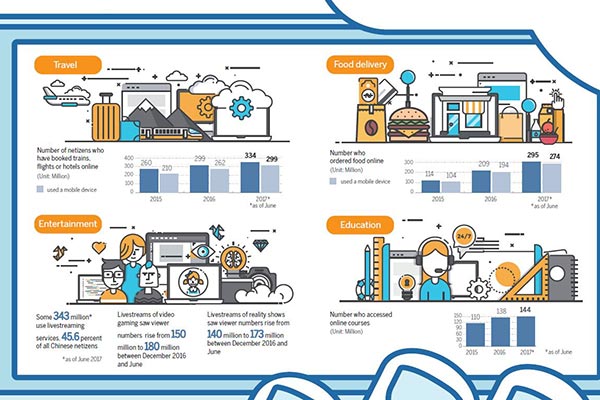Another brick in the wall for web retailers
Chinese shoppers have array of outlets as brands cross over into cyberspace
Shoppers have never had it so good as online companies search for offline opportunities and traditional stores look for a home in cyberspace.
Brands have been able to cash in on rising internet spending, while consumers have a greater variety of products and outlets.
"This trend has helped provide consumers with a better shopping experience and enabled brands to achieve incremental growth," said Jason Yu, general manager of Kantar Worldpanel China.
Leading this retail revolution has been Alibaba Group Holding Ltd, which has been expanding offline. On Nov 21, it acquired a 36.16 percent stake in China's largest hypermarket operator Sun Art Retail Group.
The chain store giant dominates the hypermarket business with a market share of 15 percent, consultancy Euromonitor International reported.
"To join forces with Sun Art, Alibaba is looking to seamlessly integrate more than 500 million 'super consumers' at its e-commerce platform that sells everything from fresh products to electronics, with this well-established brick-and-mortar retail network," Daniel Zhang, CEO of Alibaba, told China Daily.
"As the country's 'super consumers' are reshaped by the internet, the boundary between the online and offline retail arenas continues to be blurred," he added. "It becomes a big trend when an e-commerce giant and a hypermarket operator form a strong alliance."
Sun Art operates about 450 hypermarkets across China under the RT-Mart and Auchan banners.
The HK$22.4 billion ($2.88 billion) deal will make Alibaba the second-largest stakeholder in a business which generated 100 billion yuan ($15.09 billion) of revenue last year.
"The New Retail strategy is at its starting point and it is hard to know whether it can completely change the retail landscape," said Yu, of Kantar Worldpanel China.
"But it is reforming the retail structure and driving efficiency through internet technology," he added.
Alibaba's move was part of an investment spree which started in 2014. This included buying department store chain, Intime Retail Group Co Ltd in January, and investing in Shanghai-based supermarket brand Lianhua in May.
The company is pushing ahead with its "New Retail strategy", merging online and offline commerce by using colossal amounts of data collected through its array of digital services.
JD.com Inc, China's second-biggest e-commerce player, is in a similar position.
It plans to open 200 more bricks-and-mortar stores by the end of this year. They will mainly offer consumer electronics products.
This is considered a bold move by JD as it will go head-to-head with Suning Commerce Group and Gome Electrical Appliances Holding Ltd, two of the biggest electronic offline retailers in China.
But JD has a massive online presence and some powerful partners offline.
Earlier this year, the company and one of the world's biggest retailers, Walmart Inc, joined forces to expand their strategic partnership in China.
They agreed to further integrate their platforms, supply chains and customer resources.
The two groups also confirmed that they would continue to share resources on customers, stores and inventory.
By November, the effects were visible. Sam's Club, Walmart's high-end membership store in China, reported that it had tripled its revenue in a year since going online with JD last October.
Overall, Walmart China has seen its orders surge more than 30 times after working with JD Daojia services. The collaboration covers 146 stores in 20 cities.
"Since forming our strategic partnership with JD.com in June last year, we have continued to expand our omni-channel strategy to better serve customers and grow our business in China," Ben Hassing, senior vice-president of Walmart China e-commerce and technology, told China Daily.
Today, the digitally adept consumers are always connected, browsing products on the move and comparing prices. It is in this space that retail brands now need to position themselves.
Starbucks is a classic example. It has used its digital presence to connect with consumers.
In February, the coffeehouse chain launched, "Say it with Starbucks", a new social gifting feature on Weixin, the country's leading mobile social communications service.
This pioneering offline-to-online move enabled users to instantly, and conveniently, "gift" a Starbucks beverage or digital gift card to friends or family.
"Starbucks is the first retail brand to bring to life a locally-relevant social gifting experience in China," Molly Liu, vice-president at China Digital Ventures, told China Daily at the time.
The world's second largest economy will continue to be at the cutting-edge of this online-to-offline and offline-to-online transformation along with other Asian countries.
But the big surge will come in the next decade. The United States' e-commerce share is predicted to rise from 1.5 percent this year to 8 percent in 2025, according to Kantar Worldpanel report.
A successful rollout of 'click and collect', and delivery and subscription models, will accelerate growth in the US sector.
Indeed, worldwide sales of groceries on e-commerce platforms jumped by 30 percent in the 12 months to March, 2017, according to a Kantar Worldpanel report released in November and entitled, The Future of E-commerce in FMCG.
The study showed that e-commerce accounted for 4.6 percent of all fast moving consumer goods sales globally during the same period.
While the e-commerce channel has been growing, the market as a whole has been sluggish. It increased just 1.3 percent.
Still, e-commerce growth in global fast moving consumer goods hit a record 36 percent and outpaced the offline sector.
"Our projections show that in 2025, online FMCG will be a $170-billion business and hold a market share of 10 percent," said Stephane Roger, global shopper and retail director at Kantar Worldpanel.
In terms of absolute value growth, the top six were all leading economies, led by China and the US. The others were South Korea, the United Kingdom, Japan and France.
Nearer home, "New Retail" is the result of efforts to find solutions to a distinct set of problems faced by online-and-offline retail companies.
"For the physical store chains, they have been unable to keep up with the growth of online retail," Matthew Crabbe, research director for the Asia-Pacific region at consultancy Mintel, told China Daily.
"For the online operators, they have struggled to keep delivery infrastructure capacity up with the rapid growth in online shopping demand," he added.


























